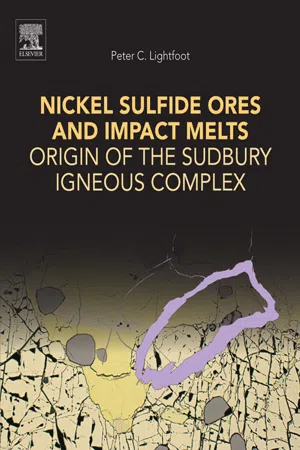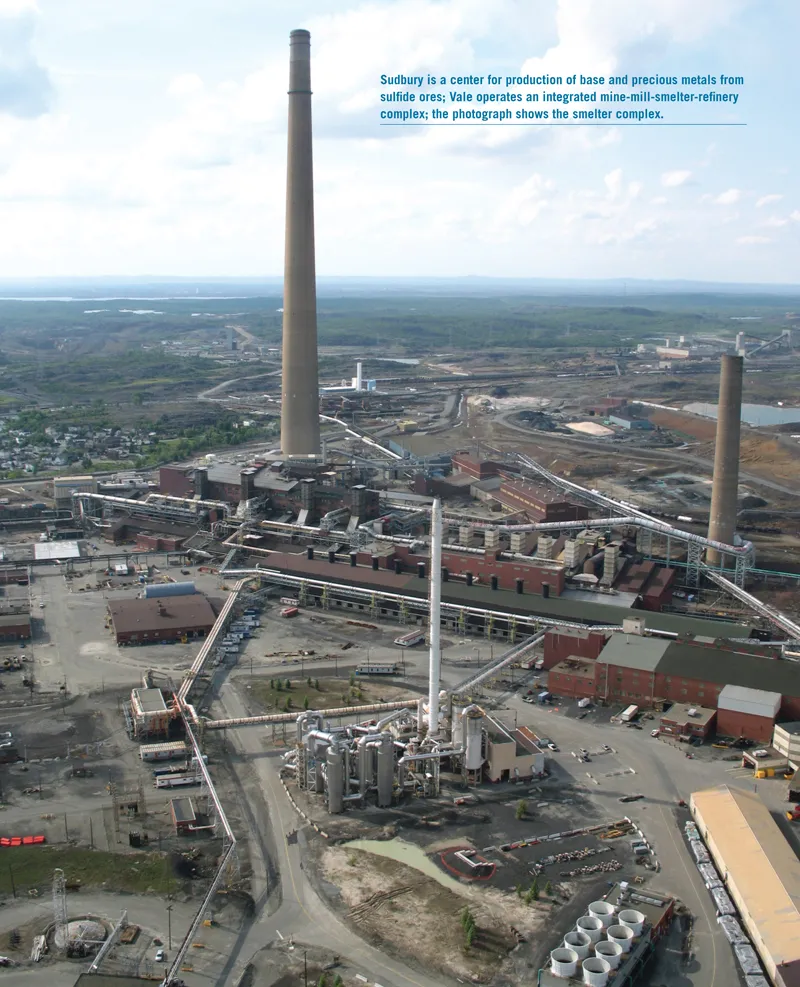
eBook - ePub
Nickel Sulfide Ores and Impact Melts
Origin of the Sudbury Igneous Complex
- 680 pages
- English
- ePUB (mobile friendly)
- Available on iOS & Android
eBook - ePub
About this book
Nickel Sulfide Ores and Impact Melts: Origin of the Sudbury Igneous Complex presents a current state of understanding on the geology and ore deposits of the Sudbury Igneous Complex in Ontario, Canada. As the first complete reference on the subject, this book explores the linkage between the processes of meteorite impact, melt sheet formation, differentiation, sulfide immiscibility and metal collection, and the localization of ores by magmatic and post-magmatic processes.
The discovery of new ore deposits requires industry and government scientists and academic scholars to have access to the latest understanding of ore formation process models that link to the mineralization of their host rocks. The ore deposits at Sudbury are one of the world's largest ore systems, representing a classic case study that brings together very diverse datasets and ways of thinking.
This book is designed to emphasize concepts that can be applied across a broad range of ore deposit types beyond Sudbury and nickel deposit geology. It is an essential resource for exploration geologists, university researchers, and government scientists, and can be used in rock and mineral analysis, remote sensing, and geophysical applications.
- Provides the only reference book to focus entirely on the Sudbury Igneous Complex
- Brings together an understanding of ore deposit and impact melts as a basis for future exploration
- Authored by a leading expert on the geology of the Sudbury Igneous Complex with 35 years of experience working on nickel sulfide ore deposits
Frequently asked questions
Yes, you can cancel anytime from the Subscription tab in your account settings on the Perlego website. Your subscription will stay active until the end of your current billing period. Learn how to cancel your subscription.
At the moment all of our mobile-responsive ePub books are available to download via the app. Most of our PDFs are also available to download and we're working on making the final remaining ones downloadable now. Learn more here.
Perlego offers two plans: Essential and Complete
- Essential is ideal for learners and professionals who enjoy exploring a wide range of subjects. Access the Essential Library with 800,000+ trusted titles and best-sellers across business, personal growth, and the humanities. Includes unlimited reading time and Standard Read Aloud voice.
- Complete: Perfect for advanced learners and researchers needing full, unrestricted access. Unlock 1.4M+ books across hundreds of subjects, including academic and specialized titles. The Complete Plan also includes advanced features like Premium Read Aloud and Research Assistant.
We are an online textbook subscription service, where you can get access to an entire online library for less than the price of a single book per month. With over 1 million books across 1000+ topics, we’ve got you covered! Learn more here.
Look out for the read-aloud symbol on your next book to see if you can listen to it. The read-aloud tool reads text aloud for you, highlighting the text as it is being read. You can pause it, speed it up and slow it down. Learn more here.
Yes! You can use the Perlego app on both iOS or Android devices to read anytime, anywhere — even offline. Perfect for commutes or when you’re on the go.
Please note we cannot support devices running on iOS 13 and Android 7 or earlier. Learn more about using the app.
Please note we cannot support devices running on iOS 13 and Android 7 or earlier. Learn more about using the app.
Yes, you can access Nickel Sulfide Ores and Impact Melts by Peter C. Lightfoot in PDF and/or ePUB format, as well as other popular books in Physical Sciences & Natural Resource Extraction Industry. We have over one million books available in our catalogue for you to explore.
Information
Chapter 1
Sudbury – an introduction to the ore deposits and the impact structure

Introduction to Sudbury
Three facts about the Sudbury Structure place it among the crown jewels of planetary geoscience: (1) It is one of the largest, oldest, and best-preserved impact structures on planet Earth; (2) it was and remains the birthplace of important geoscience controversies in igneous petrogenesis, ore deposit geology, and impact cratering; and (3) it is home to Canada’s largest mining camp with more than 100 years of mining activity on deposits of high-grade nickel sulfide ores. Quite how these three themes and the many strands of science and discovery that underpin them have evolved into a holistic understanding of the geology of Sudbury make it a classic study in Earth Sciences.
Wagner’s views on continental drift, and the theory of plate tectonics were at the root of a revolution in Earth Sciences in the 20th century (Wegener, 1929), but the sudden and catastrophic events that change the planet in seconds to years rather than millions of years are at the crux of a shift in geoscience emphasis away from progressive (albeit rapid) change to sudden and profound shifts in the configuration of planet Earth. The Sudbury Structure is a case study in rapid change. Its formation was triggered by an impact event that lasted a fraction of a second followed by a crustal readjustment period likely lasting much less than 250,000 years. Exploration and mining activities over a period of more than 100 years in the Anthropocene underpin our current three-dimensional understanding of the geology of the shallow part of the Sudbury Structure above ∼3 km depth. The path to our current understanding has triggered many epiphanies and quite a few global revolutions in the Earth Sciences. Living in the footprint of an astrobleme, one has a privileged opportunity to understand the complex geology as an outcome of a catastrophic event that happened on a short time scale relative to the slow motion of plate tectonics and mantle plumes. This book is written to explain the importance of geoscience, exploration, and discovery as it relates to not just ore deposits, but the further understanding of the Sudbury impact structure.
The City of Sudbury, located in Northeastern Ontario, Canada, is one of the world’s principal sites of global nickel production; it is a city with a mineral industry that has evolved through almost 130 years. Since the discovery of the ore deposits, over 11.1 million metric tons of nickel and 10.8 million metric tons of copper together with by-products of cobalt, silver, gold, and platinum group elements (PGE) have been mined from the ore deposits (modified after Mudd, 2010). This wealth has been and continues to be generated from seven major mine complexes and 21 smaller ore deposits around the outer margin of the SIC which comprises part of the Sudbury Structure; the principal mines are owned and operated by international mining companies (Vale, Glencore, KGHM) and smaller mining companies (eg, Wallbridge). The high-grade ore deposits of the SIC are among the largest known historically mined and future resources of Ni–Cu–PGE sulfides, and comprise the foundation of the economic wealth of one of the largest mining camps in the world. The economic wealth generated at Sudbury in terms of just nickel and copper value at current metal prices (± March 2015 nickel price) is close to 215 billion US dollars. The Sudbury Nickel Camp has underpinned the growth of the economy of Canada and Ontario, inspired contributions to the science of magmatic ore deposit geology (Naldrett, 2004), triggered the development of exploration technologies such as airborne geophysics and down-hole electromagnetic geophysical tools (Polzer, 2000; King, 2007), and provided a foundation for the development of mining technologies to handle the challenges of extraction of mineral from deep mines, the process technology for sulfide ores, and the foundation for the future growth of a global service center in the City of Sudbury in Northeastern Ontario.
The Sudbury Nickel Camp is second in the world in terms of contained Ni in sulfide deposit (contained metal in historic production and unmined reserves and resources), behind that of the Noril...
Table of contents
- Cover
- Title page
- Table of Contents
- Copyright
- Dedication
- Preface
- Acknowledgments
- Chapter 1: Sudbury – an introduction to the ore deposits and the impact structure
- Chapter 2: A synthesis of the geology of the Sudbury Structure
- Chapter 3: Petrology and geochemistry of the Sudbury igneous complex
- Chapter 4: The mineral system characteristics of the Sudbury Ni-Cu-Co-PGE sulfide ore deposits
- Chapter 5: The relationship between the impact melt sheet and the Ni-Cu-PGE sulfide mineral systems at Sudbury
- Chapter 6: Sudbury nickel in a global context
- References and Sudbury Bibliography
- Index